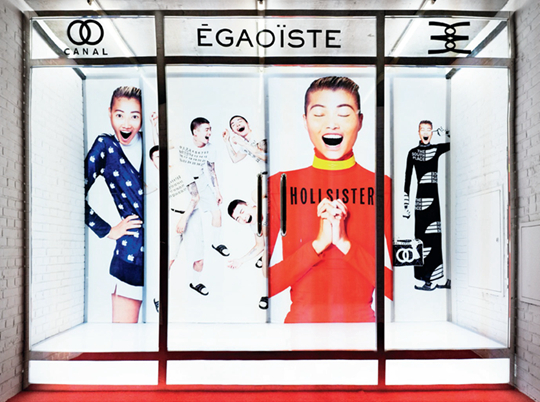SHANZHAI
| July 27, 2015 | Post In 2015年6月号

Courtesy Shanzhai Biennial
Shanzhai is neither an Instagram geotag nor a city in China hosting a biennial— despite our multiple efforts to make this the case. As co-president of the Shanzhai Biennial (with Avena Gallagher and Babak Radboy), we have been active since fall 2012; with three installments (SB1 at Beijing Design Week, SB2 at MoMA PS1, and SB3 at Frieze Art Fair) in the course of three years, we are known as the biennial with the fastest turnaround in the whole industry. The original Mandarin phrase shanzhai translates as “fortified mountain refuge,” a place where ancient bandits hid in secrecy to stockpile goods and wealth, illustrating the contemporary mechanisms of a Robin Hood role model for the redistribution of wealth and cultural capital. Originally coined to refer to illegal electronic goods of poor quality from the southern city of Shenzhen, it has quickly and exponentially risen to a cultural genre of appropriation, combination, recreation, and parody applied to modern consumerism: shanzhai garments, goods, magazines, brands, but also pop stars, TV shows, gas stations, and museums.
Constantly reappropriated by recent tropes of late western capitalism (think of Jeremy Scott for Moschino and M.I.A. using Versace bootlegs to produce a capsule collection for Versace), the genre known as shanzhai stands as one of the most emblematic and original forms of creative appropriation in the cultural industries. Through an unfortunate pseudo-intellectual formalism, it is often reduced to the simple notion of counterfeit; in fact it produces the exact opposite. The sole purpose of the counterfeit luxury good is to mimic the original and simulate equivalent social status for its owner, while a shanzhai good is an intellectual construction and assemblage of cultural symbols and icons that encompasses a power of attraction. Some of the most sophisticated manifestations can be read in multiple ways and gather several cultural references into a single entity.

Courtesy Project Native Informant and Shanzhai Biennial
Far from Chinese middle class preoccupations with symbols of luxury and wealth—closer to the grassroots labor crushed by multinationals in a cynically unshackled production economy—a message is sent towards the upper classes: the true arrogant and libertarian display of countercultural production muscle backfiring at shamelessly unethical production models. Or, as my co-president Babak Radboy says: “How to distill the whole world into a pair of sneakers.” M+ curator Aric Chen calls shanzhai the “pop art of China” in that it is a literal translation of China’s understand-ing of the emergence of its own intellectual leadership in the integration and transformation of western sensibilities and twentieth-century capitalism. By reversing the engineering of capitalism for its own benefit, a shadow industry of anonymous and collaborative ghost-design has risen. With international ramifications and systems of distribution in the Middle East and Central America, it is as impossibly unquantifiable as Cosa Nostra itself.
After years of studying the mechanisms of shanzhai through our travels and branding experiments (“a multinational brand posing as an art-project posing as an multinational brand posing as a biennial”), our enterprise is clear: being shanzhai, not acting like it. Each of our projects is carefully planned, financed, advertised, and eventually disclosed to a global audience. The starting point is always an invitation (from a cultural institution or brand) that triggers a mechanism within our working process: local social components become specific sources of inspiration and commentary to unfold through our advertising campaigns and a physical result. For each biennial, we navigate concepts and contexts to refresh the aura of our brand. As Radboy told T, “the advertising campaign has more in common with a military campaign: It is first and foremost concerned with territory and not cash.”

